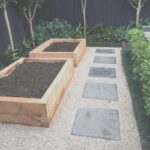Vegetable gardens have surged in popularity in recent years, particularly in urban and suburban areas. As more people recognize the value of growing their own food, the need for a solid foundation for these gardens becomes crucial. This raises the question: is concrete a safe option for vegetable gardens?
In this article, we will explore the benefits of having a vegetable garden and the role that concrete plays in providing a stable base. We will also delve into the potential effects of concrete on soil quality, nutrient availability, drainage, pest control, and ultimately, the safety of consuming vegetables grown in concrete-based gardens.
Having a vegetable garden brings numerous advantages to individuals and communities alike. Not only does it allow you to have fresh and nutritious produce just steps away from your kitchen, but it also provides an opportunity to engage with nature and promote sustainability.
Additionally, vegetable gardens can beautify outdoor spaces and contribute to improved air quality. However, to ensure long-term success with your vegetable garden, it is important to have a solid foundation that provides stability and support for your plants.
This is where concrete comes into play. Known for its strength and durability, concrete is often used as a base material for various structures. But is it safe to use concrete in vegetable gardens?
Throughout this article, we will address this question by examining the composition of concrete, its potential effects on soil quality and nutrient availability, drainage considerations, pest control benefits and drawbacks, as well as any safety concerns regarding consuming vegetables grown in concrete-based gardens.
By analyzing all these factors together with best practices for maintaining a safe and productive concrete vegetable garden, readers will be equipped with the knowledge needed to make an informed decision based on their specific gardening needs.
Understanding the Composition of Concrete and Its Potential Effects on Vegetable Gardens
Concrete is a commonly used material for various construction projects due to its strength and durability. However, when it comes to vegetable gardens, understanding the composition of concrete and its potential effects on the soil is crucial. This section will delve into the ingredients and composition of concrete, as well as discuss the concerns regarding leaching of minerals and chemicals into the soil.
Concrete is primarily composed of cement, aggregates (such as sand and gravel), and water. Cement acts as a binder that holds the aggregates together, creating a solid structure. While most modern cements are relatively safe, some older types of cement may contain harmful substances such as asbestos or heavy metals like lead. It is important to use cement that meets current safety standards to avoid any potential issues.
One concern regarding concrete in vegetable gardens is the possibility of mineral leaching from the material into the soil. Over time, chemicals from the concrete can seep into the surrounding ground, potentially affecting nutrient availability for plants. Calcium hydroxide or lime is one such chemical that may be present in concrete and can increase soil alkalinity. This increase in pH levels can adversely affect plants that prefer slightly acidic conditions.
Additionally, some older concretes may contain pollutants such as fly ash or slag which could pose risks to plant health. These pollutants may contain heavy metals like arsenic, cadmium, or chromium which can be toxic to plants if present in high concentrations in the soil. It is important to test both your soil and any concrete you plan to use for any potentially harmful substances before starting your vegetable garden.
To mitigate these potential effects on vegetables grown in concrete-based gardens, there are several steps you can take. First, consider using a barrier between the concrete and soil such as a geotextile fabric or pond liner to reduce contact between them.
Additionally, regularly monitor pH levels and nutrient availability in your soil using soil testing kits or professional services so you can make any necessary adjustments. By taking these precautions, you can enjoy the benefits of using concrete in your vegetable garden while ensuring the safety of your plants and produce.
Analyzing the Impact of Concrete on Soil Quality and Nutrient Availability
Concrete, with its solid and non-porous nature, can have a significant impact on the soil quality and nutrient availability in vegetable gardens. Understanding these impacts is crucial for gardeners to make an informed decision about whether concrete is a suitable option for their vegetable garden.
One of the primary effects of concrete on soil quality is its impact on pH levels. Concrete has a high pH, meaning it is alkaline. When alkaline materials come into contact with soil, they can raise the pH level, making it more alkaline.
This increase in alkalinity can affect the availability of nutrients to plants, as certain nutrients become less mobile and less readily absorbed by plant roots in alkaline soils. If a gardener chooses to use concrete in their vegetable garden, they should regularly monitor and adjust the pH levels of the soil to ensure optimal nutrient uptake by plants.
Another potential impact of concrete on soil quality is compaction. When concrete is used as a base or flooring material in a vegetable garden, it can restrict oxygen flow and water drainage into the underlying soil. This restriction can lead to compacted soil, which hinders root growth and affects overall plant health. To mitigate this issue, gardeners should consider incorporating compost or other organic matter into the soil to improve its structure and promote better drainage.
In addition to affecting the physical properties of soil, concrete also has implications for microbial life within the soil. Concrete’s non-porous nature prevents air exchange between the atmosphere and the soil beneath it.
This reduced oxygen availability can negatively impact beneficial microbes that play a crucial role in breaking down organic matter and cycling nutrients in the soil. To support healthy microbial activity when using concrete in vegetable gardens, gardeners can incorporate beneficial microorganisms through compost or organic fertilizers.
Examining Drainage and Watering Considerations in Concrete-based Vegetable Gardens
Understanding the Drainage Properties of Concrete
One important consideration when using concrete in vegetable gardens is its drainage properties. Concrete is known for being a nonporous material, which means that it does not allow water to pass through easily. This can be both an advantage and a disadvantage for vegetable gardens.
On one hand, having a solid foundation like concrete can prevent excessive water drainage and help retain moisture in the soil. This is especially beneficial in areas with heavy rainfall or where water conservation is a concern. Concrete can act as a natural water reservoir, providing plants with access to moisture during dry periods.
However, the lack of porosity in concrete can also lead to poor drainage, which can result in waterlogged soil and root rot. Excess water may accumulate on the surface or at the bottom of the garden bed, preventing proper oxygen circulation to plant roots. It is essential to find a balance between retaining enough moisture and preventing waterlogging in order to maintain optimal growing conditions.
Methods to Improve Drainage in Concrete-based Gardens
To improve drainage in concrete-based vegetable gardens, there are several strategies that gardeners can employ:
- Incorporate drainage holes: Drilling small holes at regular intervals along the bottom of the garden bed can promote better drainage by allowing excess water to escape.
- Create a gravel layer: Placing a layer of gravel at the bottom of the garden bed before pouring concrete can provide an additional drainage pathway for water.
- Use raised beds or containers: Building raised beds or using containers instead of directly pouring concrete onto the ground allows for better control over soil moisture levels and improved overall drainage.
- Install an irrigation system: Implementing an irrigation system with drip emitters can ensure efficient watering without saturating the soil excessively.
By implementing these methods, gardeners can strike a balance between providing adequate moisture retention and preventing issues associated with poor drainage, ultimately promoting healthier plant growth.
Tips for Watering Appropriately in Concrete-enclosed Beds
In vegetable gardens with concrete enclosures, proper watering techniques are essential to maintain healthy plant growth and prevent water-related issues. Here are some tips for watering appropriately in concrete-based beds:
- Monitor soil moisture: Regularly check the moisture level of the soil using a moisture meter or by inserting your finger into the soil up to the first knuckle. Water when the top inch of soil feels dry.
- Water deeply but infrequently: Instead of applying small amounts of water frequently, water deeply and thoroughly to encourage deep root growth. This helps plants become more resilient and withstand drought conditions.
- Consider mulching: Apply a layer of organic mulch, such as straw or wood chips, around your plants to help retain moisture in the soil and reduce evaporation.
- Time your watering: Water early in the morning or late in the afternoon to minimize water loss due to evaporation during hot daytime temperatures.
By following these watering practices, gardeners can ensure that their vegetables receive adequate hydration while preventing issues associated with overwatering or poor drainage.
Concrete as a Pest and Weed Barrier in Vegetable Gardens
Concrete can play a crucial role as a pest and weed barrier in vegetable gardens. When properly installed, concrete can help prevent unwanted pests and weeds from infiltrating the garden beds and causing damage to the crops. By creating a physical barrier, it becomes more difficult for pests like rodents, rabbits, and ground-dwelling insects to access the plants.
One of the main advantages of using concrete as a pest barrier is its durability. Unlike other materials that may degrade over time or be easily breached by pests, concrete offers long-lasting protection against intrusion. It can withstand the digging and gnawing efforts of burrowing animals and deter crawling pests from accessing the plants.
Additionally, concrete minimizes weed growth in the garden beds. Weeds can compete with vegetable plants for nutrients, water, and sunlight, potentially stunting their growth or even killing them. The solid surface of concrete blocks weed seeds from contacting the soil where they would typically germinate, reducing the need for manual weeding or herbicide use.
While concrete can provide effective pest and weed control, there are some potential drawbacks to consider. Concrete creates limited accessibility for beneficial insects and worms that are essential for maintaining a healthy ecosystem in the garden. Bees, ladybugs, spiders, earthworms, and other beneficial organisms may struggle to access the garden beds due to physical barriers created by concrete.
To offset this limitation, it is crucial to incorporate alternative pest control methods into your gardening practices. Implementing companion planting techniques can attract beneficial insects to your garden beds despite their limited accessibility. For example, planting flowers such as marigolds or lavender near concrete beds can attract pollinators like bees while repelling certain pests.
Gardeners should consider their specific needs and priorities to determine whether concrete is the right choice for their vegetable garden. Implementing companion planting techniques and other pest control methods can help mitigate the restricted accessibility for beneficial organisms and maintain a healthy ecosystem in the garden.
Evaluating the Safety of Consuming Vegetables Grown in Concrete-based Gardens
When considering whether concrete is safe for vegetable gardens, an important concern is the potential chemical contaminants that may be absorbed by plants and ultimately consumed by humans. Concrete contains various minerals and chemicals that have the potential to leach into the soil and affect the safety of the vegetables grown in it.
Research has shown that certain minerals and chemicals present in concrete, such as lead, cadmium, and chromium, can pose health risks if they accumulate in high levels in fruits and vegetables. These heavy metals can originate from different sources like aggregates used in concrete or additives. However, studies have also demonstrated that the risk of contamination from concrete is generally low when compared to other potential sources of contamination.
To minimize any potential risks, certain practices can be implemented when using concrete for vegetable gardening. One approach is to create a barrier between the concrete and the soil by lining or sealing it. This will help prevent direct contact between the soil and any potential contaminants leaching from the concrete. Additionally, using an organic compost or topsoil layer on top of the concrete can act as a protective barrier.
Regular soil testing can also provide valuable information about any existing contamination levels. Testing for heavy metals and other contaminants before establishing a vegetable garden can help determine if additional precautions are necessary or if alternative gardening methods should be considered.
| Potential Contaminants | Health Risks | Minimizing Risks |
|---|---|---|
| Lead | Impaired brain and nervous system development, kidney damage, increased blood pressure | – Create a barrier between concrete and soil
|
| Cadmium | Kidney damage, bone health issues, potential carcinogenic effects | – Line or seal the concrete to prevent direct contact with the soil
|
| Chromium | Skin irritation, respiratory issues, potential carcinogenic effects (hexavalent chromium) | – Regular monitoring of soil and water quality for chromium levels
|
Choosing the Right Type of Concrete for Vegetable Gardens
Concrete is a commonly used material for creating a solid foundation in vegetable gardens. However, not all types of concrete are suitable for this purpose. When choosing the right type of concrete for your vegetable garden, it is important to consider factors such as porosity, sustainability, and potential chemical leaching.
One option to consider is traditional concrete, which is made from a mixture of cement, sand, and aggregate. Traditional concrete is widely available and affordable, making it a popular choice for many gardeners. However, it has limited permeability, which can lead to poor drainage and waterlogging in the garden beds.
This can be detrimental to the health of your plants and increase the risk of root rot. Therefore, if you choose to use traditional concrete in your vegetable garden, it is crucial to ensure proper drainage by incorporating amendments such as gravel or creating channels for water flow.
Another option to consider is porous or pervious concrete. This type of concrete contains voids that allow water to drain through more easily. These voids can be created by using larger aggregates or adding special admixtures that enhance permeability. Porous concrete offers better drainage compared to traditional concrete and helps prevent waterlogging in the garden beds. Additionally, it promotes natural filtration of rainwater into the soil, reducing runoff and protecting nearby bodies of water from pollution.
Recycled concrete is gaining popularity as a sustainable alternative for vegetable gardens. This type of concrete is made from recycled materials like crushed brick or reclaimed aggregate mixed with cementitious binders. Using recycled materials reduces environmental impact and conserves natural resources.
Recycled concrete also tends to have good drainage properties due to its coarse nature. However, it’s important to ensure that recycled materials used in the production process do not contain harmful contaminants that could affect plant growth or pose risks when consumed.
| Type of Concrete | Pros | Cons |
|---|---|---|
| Traditional Concrete | Widely available and inexpensive | Poor drainage, potential waterlogging |
| Porous Concrete | Better drainage, natural filtration of rainwater | May be more expensive, specialized installation required |
| Recycled Concrete | Sustainable option, good drainage properties | Potential risk of contaminants if not properly sourced and tested |
When choosing the right type of concrete for your vegetable garden, it is essential to consider the specific needs of your plants, the local climate, and your budget. By selecting a suitable concrete option that promotes proper drainage and minimizes any potential risks such as chemical leaching or contamination, you can create a safe and productive environment for your vegetable garden.
Best Practices for Maintaining a Safe and Productive Concrete Vegetable Garden
Preparing the Concrete Base
Before starting a concrete vegetable garden, it is crucial to prepare the concrete base properly. This will ensure a safe and productive growing environment for your plants. Here are some steps to follow:
- Clear the area: Remove all vegetation, rocks, and debris from the site where you plan to build your concrete vegetable garden. This will provide a clean and even surface for laying the concrete.
- Level the ground: Use a shovel or rake to level the ground where you’ll be placing the concrete. Make sure it is smooth and free from any uneven spots or bumps.
- Compact the soil: Use a compactor or tamper to compact the soil beneath where you’ll be pouring the concrete. This will help prevent settling and minimize cracks in the future.
- Install formwork: Create a frame using wooden boards around the perimeter of your desired gardening area. Ensure that it is level and perpendicular before securing it with stakes or screws.
- Reinforce with rebar (optional): Depending on your preferences and the size of your garden, you may consider reinforcing the concrete with rebar for added strength and stability.
Properly Sealing or Lining the Concrete
To minimize any potential contact between the soil and concrete, it is recommended to seal or line the concrete in your vegetable garden:
- Sealants: Apply a suitable sealant on top of the cured concrete surface to create a barrier between it and the soil. There are various types of sealants available, such as epoxy coatings or acrylic sealers, which can help protect against moisture penetration.
- Line with plastic sheets: Another option is to line your concrete garden bed with plastic sheets before filling it with soil. Make sure they overlap so that water doesn’t seep through any gaps.
- Consider food-safe options: If you have concerns about chemicals leaching into the soil, look for sealants or liners specifically labeled as food-safe. These products are designed to be non-toxic and safe for use in edible gardens.
It’s important to note that sealing or lining the concrete may add an extra layer of protection but is not foolproof. Over time, especially with wear and tear, these barriers may deteriorate. Regular maintenance and inspections are necessary to ensure their effectiveness.
Tips for Ongoing Maintenance, Irrigation, and Soil Testing
To maintain a safe and productive concrete vegetable garden, follow these best practices:
- Regularly inspect the concrete: Check for cracks or signs of deterioration in the concrete surface. Promptly repair any damages to prevent soil contact and potential contamination.
- Practice proper irrigation: Concrete can retain moisture, so it’s essential not to overwater your plants. Monitor the moisture levels in both the soil and concrete to avoid waterlogged conditions that can lead to root rot or fungal diseases.
- Conduct regular soil testing: Test your soil regularly to monitor nutrient levels and pH balance. Concrete can affect soil pH, so it’s crucial to make any necessary amendments to keep it within the optimal range for vegetable growth.
- Implement crop rotation: To prevent nutrient depletion and minimize disease pressure, practice crop rotation by changing what you plant in different areas of your concrete garden each year.
By following these best practices for maintaining a safe and productive concrete vegetable garden, you can enjoy fresh and nutritious homegrown vegetables while minimizing any potential risks associated with using concrete as a gardening material.
Conclusion
In conclusion, the use of concrete in vegetable gardens has both its pros and cons. Concrete can provide a solid foundation for vegetable beds, ensuring stability and long-term durability. It can also serve as a barrier against pests and weeds, reducing the need for chemical pesticides. However, there are concerns about the potential leaching of minerals, chemicals, and heavy metals from concrete into the soil. This may have negative impacts on soil quality and nutrient availability.
When considering whether to use concrete in your vegetable garden, it is important to weigh these pros and cons. Assessing your specific gardening needs and priorities will help you make an informed decision. If stability and longevity are important factors for you, then using concrete as a foundation may be beneficial.
However, it is crucial to minimize any potential risks associated with concrete by choosing the right type of material. Traditional concrete, porous concrete, or even recycled concrete all have their own advantages and disadvantages. Considering factors such as drainage properties, accessibility for beneficial organisms like worms and insects, and potential chemical leaching is essential in making the best choice.
Ultimately, maintaining a safe and productive vegetable garden requires ongoing maintenance and careful attention to irrigation practices. Properly preparing the concrete base, sealing or lining it to minimize contact with the soil, and conducting regular soil testing will contribute to a healthier growing environment.
Frequently Asked Questions
Is concrete good in a vegetable garden?
Concrete can have both advantages and disadvantages when used in a vegetable garden. On the positive side, concrete is durable and can create a stable foundation for raised beds or pathways. It helps retain moisture, which can be beneficial in dry climates or areas prone to drought.
Furthermore, concrete can prevent weed growth between garden beds or contribute to maintaining a clean and organized garden layout. However, it’s important to note that concrete is not an ideal material for planting directly into as it lacks porosity and adequate drainage. Therefore, if using concrete in a vegetable garden, it should be limited to supporting structures rather than being the sole medium for growing plants.
Are concrete blocks safe for vegetable gardens?
Concrete blocks are generally safe to use in vegetable gardens with some precautions. As long as they are free from harmful chemicals such as lead-based paints or sealants, they pose no direct harm to growing vegetables. Concrete blocks are often used for building raised beds due to their stability and durability.
However, it’s advised to line the inside of the blocks with materials like landscaping fabric or plastic sheeting that will act as a barrier between the soil and the concrete itself. This prevents soil contact with any potential contaminants that might leach out from the blocks over time.
Is it safe to grow food in concrete?
While it is generally safe to grow food in concrete planters or beds when proper precautions are taken, there are some factors to consider. One primary concern is ensuring that the concrete being used does not contain any toxic substances that could transfer into the soil and subsequently contaminate your crops. Additionally, since concrete lacks natural porosity, ensuring adequate drainage becomes crucial to prevent waterlogging and root rot issues.
Therefore, it’s important to incorporate drainage holes or layer gravel at the base of concrete containers before adding potting soil for optimal plant health. Ultimately, by addressing potential risks associated with specific materials and properly managing water flow within concrete structures, growing food in them should be safe and viable.

If you’re looking to get into vegetable gardening, or are just looking for some tips on how to make your current garden better, then you’ve come to the right place! My name is Ethel and I have been gardening for years. In this blog, I’m going to share with you some of my best tips on how to create a successful vegetable garden.





